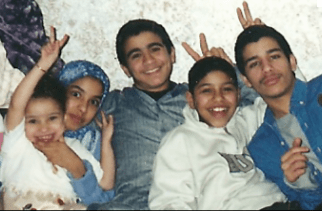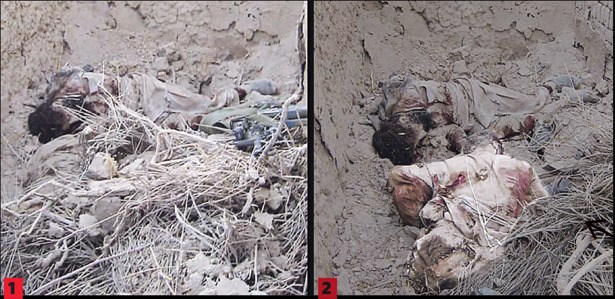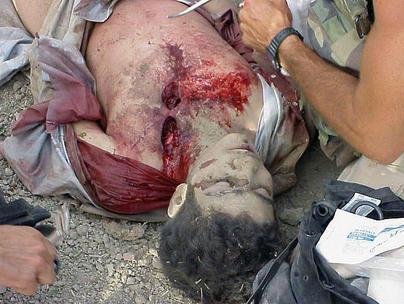May 19, 2020
 Omar Khadr (centre in the picture) was born in Toronto, Canada on September 19, 1986. His father was an Egyptian born Canadian who ran charities to provide food and education for orphans, and was an old friend of Osama Bin Laden. His mother was a Canadian of Palestinian descent. Omar spoke four languages fluently. When he was 15, his family sent him to accompany a group as a translator. The US military identified that group as Al Qaeda.
Omar Khadr (centre in the picture) was born in Toronto, Canada on September 19, 1986. His father was an Egyptian born Canadian who ran charities to provide food and education for orphans, and was an old friend of Osama Bin Laden. His mother was a Canadian of Palestinian descent. Omar spoke four languages fluently. When he was 15, his family sent him to accompany a group as a translator. The US military identified that group as Al Qaeda.
In July 2002, US Special Forces attacked the camp where he was staying. When US military entered the site, Omar was buried face down under rubble, blinded by shrapnel and crippled. Another man was beside him. US military documents say a US militant stood on top of Omar’s body before realizing that someone was buried beneath. The first US fighter to arrive on the scene shot the man beside Omar dead and then shot Omar twice in the back, leaving two large exit wounds in his chest and chunks of his chest and shoulder … blown out. He was somehow identified as being the son of his father, either before or after a second US militant prevented the first from shooting him again. He was consequently captured instead.
During the attack on the camp, a US special forces soldier was wounded and later died. There is evidence from forensic analysis of his wounds that he was killed by a US grenade, which the camp did not have, and US military was throwing grenades into the compound at the time of his injury. The US military rewrote the initial report of Omar’s capture to make it look as though he had thrown the grenade, possibly to defend their actions in shooting a shrapnel wounded and buried fifteen year old in the back.
From Lawyers Rights Watch Canada: February also saw the accidental release of a five-page “OC-1” witness report to reporters, which revealed that Omar had not been the only survivor in the compound, as previously claimed, and that nobody had seen him throw the grenade. Officials insisted that the reporters all had to return their copies of the document or face expulsion from the hearings, but after a 90-minute standoff between reporters and military officials, it was agreed that they could retain their copies of the report, but had to redact three names from the report. In March, Kuebler insisted that “Lt. Col. W.” had initially written in his report the day after the firefight that “the person who threw a grenade that killed Sgt. 1st Class Christopher J. Speer also died in the firefight”, implying that the grenade had indeed been thrown by the surviving Mujahideen, and not by Omar. The report was rewritten months later to say that the grenade thrower had been “engaged”, rather than “killed”, changing the wording that exonerated Omar.
Omar Khadr was found buried under the rubble in photograph one. His body was highlighted in photograph two with the rubble cleared off. Photograph one is the position from which he is being accused of throwing the grenade.

He was taken to Bagram torture camp where he was unconscious for about one week. “Interrogations” began as soon as he regained consciousness, and while he was on on a stretcher for the first two weeks to a month. According to his affidavit statement, of February 22, 2008, he was “not right and was out of my wits for about three days. I was in extreme pain and my pain was all I could focus on. … During the first three days, they would shackle my feet and hands out to my sides with handcuffs when they did not like the answers I was giving to the questions. Due to my injuries, this caused me great pain. At least two of the interrogations during these first three days occurred when I was shackled by my hands and feet and in pain. I was unable to even stand at this time, so I was not a threat, and I could tell that this treatment was for punishment and to make me answer questions and give them the answers they wanted. … During the interrogations, the pain was taking my thoughts away. After I regained consciousness after being unconscious for a week, the first soldier told me that I had killed an American with a hand grenade. They would only give me pain medication at nighttime but the interrogations occurred during the daytime.”
A torturer present at all of his Bagram ‘interrogations’ was a man named Joshua Klaus, who was convicted of his role in killing two other prisoners at Bagram, Dilawar and Mullah Habibullah in December of 2002. Omar wrote that Klaus “would often scream at me if I did not give him the answers he wanted. Several times, he forced me to sit up on my stretcher, which caused me great pain due to my injuries. He did this several times to get me to answer his questions and give him the answers he wanted. It was clear that he was making me sit up because he knew that it hurt and he wanted me to answer questions. I cried several times during the interrogation as a result of this treatment and pain. During this interrogation, the more I answered the questions and the more I gave him the answers he wanted, the less pain was inflicted on me. I figured out right away that I would simply tell them whatever I thought they wanted to hear in order to keep them from causing me such pain.”
Also from his affidavit:
- Bandage changes were used as an excuse for more abuse.
- His “interrogations” included barking dogs, bagging his head so tightly he choked, cold water thrown on him, hands pulled above his head and chained to the ceiling (with bullet wounds in his chest) for hours at a time, and making him sit up when he was on a stretcher to create pain.
- Guards made him scrub floors all night, lift and stack heavy crates and carry five gallon buckets of water to cause pain from his chest wounds. (His lawyers have documents that state his “wounds were wet” at the time.)
- Extremely bright LED lights were shone in his shrapnel wounded eyes to cause discomfort and destroy his vision (he is now blind in one eye and has poor vision in the other due to being denied medical treatment for shrapnel wounds).
- Torturers repeatedly threatened to have him raped or send him to other countries where he would be raped.
- During questioning he was frequently not allowed to use the bathroom, but forced to urinate on himself instead.
- He was told he could go free if he told them something that would help them capture someone important.
- Guards and torturers made him pick up garbage, then emptied it and made him pick it up again repeatedly, farted in his face, spit in his face and interrogated him approximately 42 times in 90 days.
- Before being transferred to Guantanamo in October 2002, the prisoners were given no food for two nights and one day, had their heads and beards shaved, and were put in mouth and nose masks, goggles and earphones and shackled to the floor for the entire trip.
- They were dragged off the plane, stripped naked and cavity searched.
- After an initial two days in hospital where he was interrogated for six hours each day, Omar was put into isolation.
- The torture continued as before, including forcing him to urinate on himself then using him as a human mop to scrub urine and pine oil off the floor and leaving him in those clothes for days.
The picture below shows the condition Omar was in when he arrived at Bagram.

Not only was Omar given no consideration for his age, he was “treated worse than anyone else” according to cellmate Moazzem Begg. Australian prisoner David Hicks wrote, “On one occasion, I saw US soldiers dragging Omar from his cage to a room used for interrogation just opposite from mine. For at least an hour, I heard him scream and yell in pain as they abused him. Omar was yelling, ‘Why are you doing this? … Please stop. … Somebody help me!’ There seemed to be no point to this brutality except to hurt him and break his will.” He was also reportedly drugged, subjected to extreme temperatures for long periods, and refused basic medical treatment including the removal of shrapnel from his wounds.
Besides being in contravention of the Optional Protocol to the Convention on the Rights of the Child on the involvement of children in armed conflict, which both Canada and the United States have signed and ratified, Omar’s treatment is completely contrary to the US government’s own recommendations for the treatment of minors at Guantanamo, on every single point.
Here is Omar’s story as explained by Dennis Edney of his Canadian defense team. He explains not just the circumstances of Omar’s abduction and imprisonment, but also who Omar is today. Although the quote in the title of this article is from the video below, it is echoed by similar statements from almost everyone who has spoken to Omar throughout his confinement, defense attorneys (both currently employed and fired), psychiatrists, cellmates, and guards.
Resources for information on Omar Khadr
- Previous WL Central coverage of Omar Khadr here.
- If you only have a few minutes to click on one link, this is it. Defense attorney Dennis Edney.
- Orwellian Circus Khadr’s trial.
- Michelle Shephard is a Canadian journalist who has covered Omar extensively and wrote a book, Guantanamo’s Child about his detention.
- Videos from Michelle Shephard’s website.
- Documentary from CBC, The U.S. vs Omar Khadr.
- Khadr timeline from CBC.
- Khadr in the US state cables
- Documentary You Don’t Like The Truth
- Moazzam Begg: Who Cares For This Boy?
- University of Toronto Faculty of Law archive on Khadr’s case
- Lt. Cmdr. William C. Kuebler and Rebecca S. Snyder, U.S. Department of Defence attorneys report on Khadr’s case on March 26, 2020
- Defense attorney Dennis Edney at the human rights film festival
- Amnesty Canada Omar Khadr Sentencing Concludes: One Last Injustice
Omar Khadr Part 2 of 4: Canada, the entire world is still watching
Omar Khadr Part 3 of 4: “The world doesn’t get it”
Omar Khadr Part 4 of 4: “Punitive post-conviction confinement”
